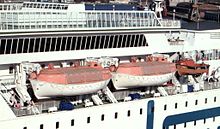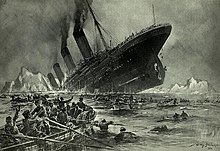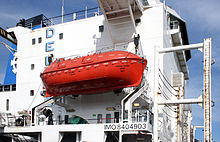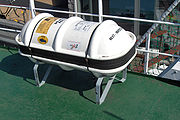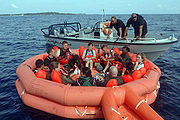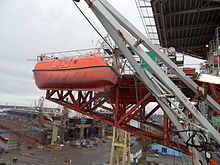
A boat is a watercraft of a large range of types and sizes, but generally smaller than a ship, which is distinguished by its larger size, shape, cargo or passenger capacity, or its ability to carry boats.

A dinghy is a type of small boat, often carried or towed by a larger vessel for use as a tender. Utility dinghies are usually rowboats or have an outboard motor. Some are rigged for sailing but they differ from sailing dinghies, which are designed first and foremost for sailing. A dinghy's main use is for transfers from larger boats, especially when the larger boat cannot dock at a suitably-sized port or marina.

An inflatable boat is a lightweight boat constructed with its sides and bow made of flexible tubes containing pressurised gas. For smaller boats, the floor and hull are often flexible, while for boats longer than 3 metres (9.8 ft), the floor typically consists of three to five rigid plywood or aluminium sheets fixed between the tubes, but not joined rigidly together. Often the transom is rigid, providing a location and structure for mounting an outboard motor.

Capsizing or keeling over occurs when a boat or ship is rolled on its side or further by wave action, instability or wind force beyond the angle of positive static stability or it is upside down in the water. The act of recovering a vessel from a capsize is called righting. Capsize may result from broaching, knockdown, loss of stability due to cargo shifting or flooding, or in high speed boats, from turning too fast.
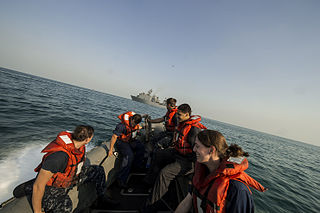
A personal flotation device is a flotation device in the form of a vest or suit that is worn by a user to prevent the wearer from drowning in a body of water. The device will keep the wearer afloat with their head and mouth above the surface – they do not have to swim or tread water in order to stay afloat and can even be unconscious.

A survival kit is a package of basic tools and supplies prepared as an aid to survival in an emergency. Civil and military aircraft, lifeboats, and spacecraft are equipped with survival kits.
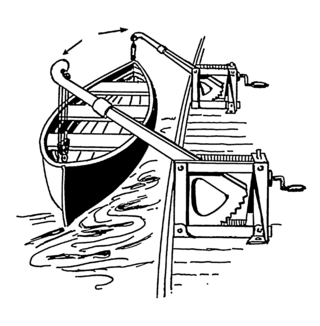
A davit is any of various crane-like devices used on a ship for supporting, raising, and lowering equipment such as boats and anchors.

Canoe diving and Kayak diving are recreational diving where the divers paddle to a diving site in a canoe or kayak carrying all their gear in or on the boat to the place they want to dive. Canoe or kayak diving gives the diver independence from dive boat operators, while allowing dives at sites which are too far to comfortably swim, but are sufficiently sheltered.

A survival suit, more accurately and currently referred to as an immersion suit, is a type of waterproof dry suit intended to protect the wearer from hypothermia if immersed in cold water or otherwise exposed after abandoning a vessel, especially in the open ocean. Immersion suits usually have integral footwear, and a hood, and either built-in gloves or watertight wrist seals. Suits manufactured by several manufacturers also include an inflatable pillow which is permanently attached high on the back, or an inflatable tube that is attached with zippers at two points on the chest, each side of the main zipper, and circles the back. When inflated, both of these devices provide enhanced stability to the wearer, which, if conscious, allows them to keep the head above water, and to keep wind and seas from striking the face. The inflation tube is routed from the inflatable pillow over the left shoulder of the user, and secured in a loop on the chest.

An able seaman (AB) is a seaman and member of the deck department of a merchant ship with more than two years' experience at sea and considered "well acquainted with his duty". An AB may work as a watchstander, a day worker, or a combination of these roles. Once a sufficient amount of sea time is acquired, then the AB can apply to take a series of courses/examinations to become certified as an officer.
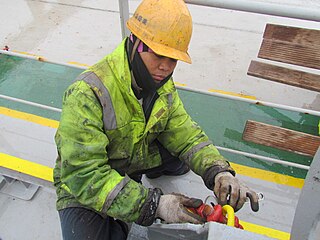
An ordinary seaman (OS) is a member of the deck department of a ship. The position is an apprenticeship to become an able seaman, and has been for centuries. In modern times, an OS is required to work on a ship for a specific amount of time, gaining what is referred to as "sea time". For centuries, the term ordinary seaman was used to refer to a seaman with between one and two years' experience at sea, who showed enough seamanship to be so rated by their captain. Historically, in some navies and the merchant marine, a sailor with less experience was called a landsman.

A marine evacuation system (MES) is a lifesaving device found on many modern passenger ships or oil rigs consisting of an inflatable slide or escape chute where a passenger can evacuate straight into waiting life rafts. Developed in 1979 by RFD, a New Zealand–based company that distributes safety equipment; MES is replacing traditional davit-launched life rafts used on ships.

Steven Callahan is an American author, naval architect, inventor, and sailor. In 1981, he survived for 76 days adrift on the Atlantic Ocean in a liferaft. Callahan recounted his ordeal in the best-selling book Adrift: Seventy-six Days Lost at Sea (1986), which was on The New York Times best-seller list for more than 36 weeks.

The Carley float was a form of invertible liferaft designed by American inventor Horace Carley (1838–1918). Supplied mainly to warships, it saw widespread use in a number of navies during peacetime and both World Wars until superseded by more modern rigid or inflatable designs. Carley was awarded a patent in 1903 after establishing the Carley Life Float Company of Philadelphia.
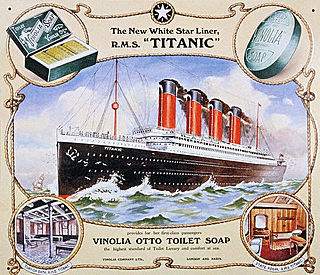
The sinking of the Titanic resulted in the following changes in maritime policy:

Airborne lifeboats were powered lifeboats that were made to be dropped by fixed-wing aircraft into water to aid in air-sea rescue operations. An airborne lifeboat was to be carried by a heavy bomber specially modified to handle the external load of the lifeboat. The airborne lifeboat was intended to be dropped by parachute to land within reach of the survivors of an accident on the ocean, specifically airmen survivors of an emergency water landing. Airborne lifeboats were used during World War II by the United Kingdom and on Dumbo rescue missions by the United States from 1943 until the mid-1950s.

The vessel MV Blythe Star was a coastal freighter which foundered off south-western Tasmania in October 1973. The crew of 10 successfully took to a small inflatable liferaft but drifted undiscovered. A search for the ship and its crew led to the largest maritime search operation conducted in Australia to that time.
Life-saving appliances are those appliances that protect human life at sea. The devices are documented as part of the International Convention for the Safety of Life at Sea, or SOLAS Convention.

MS Estonia sank on Wednesday, 28 September 1994, between about 00:50 and 01:50 (UTC+2) as the ship was crossing the Baltic Sea, en route from Tallinn, Estonia, to Stockholm, Sweden. The sinking was one of the worst maritime disasters of the 20th century. It is one of the deadliest peacetime sinkings of a European ship, after the Titanic in 1912 and the Empress of Ireland in 1914, and the deadliest peacetime shipwreck to have occurred in European waters, with 852 lives stated at the time as officially lost.
Submarine rescue is the process of locating a sunk submarine with survivors on board, and bringing the survivors to safety. This may be done by recovering the vessel to the surface first, or by transferring the trapped personnel to a rescue bell or deep-submergence rescue vehicle to bring them to the surface. Submarine rescue may be done at pressures between ambient at depth, and sea level atmospheric pressure, depending on the condition of the distressed vessel and the equipment used for the rescue. Self-rescue of submarine personnel by buoyant free ascent at ambient pressure is considered submarine escape. Survivors may require recompression treatment for decompression illness.
